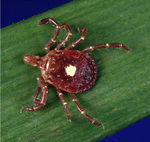Difference between revisions of "Amblyomma spp."
| Line 1: | Line 1: | ||
{{review}} | {{review}} | ||
| − | |||
{{Taxobox | {{Taxobox | ||
| Line 31: | Line 30: | ||
===''Amblyomma americanum''=== | ===''Amblyomma americanum''=== | ||
[[File:Amblyomma_americanum.jpg|150px|thumb|right|''Amblyomma americanum'', the lone star tick - CDC, Wikimedia Commons]] | [[File:Amblyomma_americanum.jpg|150px|thumb|right|''Amblyomma americanum'', the lone star tick - CDC, Wikimedia Commons]] | ||
| − | + | Also known as: '''''Lone star tick | |
| − | + | ||
| − | |||
| − | |||
| − | |||
This tick is found throughout central and eastern USA and is primarily important as a vector but has also been shown to reduce weight gain in cattle. It is responsible for transmission of ''[[Rocky Mountain spotted fever|Rickettsia rickettsii]]'', ''Francisella tularensis'', [[Q fever]] and ''Berrelia burgdorferi'' | This tick is found throughout central and eastern USA and is primarily important as a vector but has also been shown to reduce weight gain in cattle. It is responsible for transmission of ''[[Rocky Mountain spotted fever|Rickettsia rickettsii]]'', ''Francisella tularensis'', [[Q fever]] and ''Berrelia burgdorferi'' | ||
===''Amblyomma variegatum''=== | ===''Amblyomma variegatum''=== | ||
| − | + | Also known as: '''''Bont ticks — Variegated or tropical bont tick | |
| − | + | ||
| − | |||
| − | |||
| − | |||
Found throughout Africa, this tick is very important in its ability to transmit ''Cowdria ruminatium'' ([[Heartwater|heartwater]]) in Africa as well as viral Nairobi sheep disease and [[Q fever]]. There is distinct variation in the appearance of the males and female, the males are highly ornate with orange markings on the scutum compared to the brown female with a large pale patch on the scutum. | Found throughout Africa, this tick is very important in its ability to transmit ''Cowdria ruminatium'' ([[Heartwater|heartwater]]) in Africa as well as viral Nairobi sheep disease and [[Q fever]]. There is distinct variation in the appearance of the males and female, the males are highly ornate with orange markings on the scutum compared to the brown female with a large pale patch on the scutum. | ||
| + | ==Literature Search== | ||
| + | [[File:CABI logo.jpg|left|90px]] | ||
| + | |||
| + | |||
| + | Use these links to find recent scientific publications via CAB Abstracts (log in required unless accessing from a subscribing organisation). | ||
| + | <br><br><br> | ||
| + | [http://www.cabdirect.org/search.html?q=title%3A%28%22Amblyomma+americanum%22%29 ''Amblyomma americanum'' publications] | ||
| + | |||
| + | [http://www.cabdirect.org/search.html?q=title%3A%28%22Amblyomma+variegatum%22%29 ''Amblyomma variegatum'' publications] | ||
==References== | ==References== | ||
Revision as of 11:32, 27 September 2010
| This article has been peer reviewed but is awaiting expert review. If you would like to help with this, please see more information about expert reviewing. |
| Amblyomma spp. | |
|---|---|
| Kingdom | Animalia |
| Phylum | Arthropoda |
| Class | Arachnida |
| Sub-class | Acari |
| Super-order | Parasitiformes |
| Order | Ixodida |
| Super-family | Ixodoidea |
| Family | Ixodidae |
| Genus | Amblyomma |
| Species | A. americanum, A. variegatum |
These ticks can be identified by;
- Large size
- Ornate scutums
- Eyes present
- Festoons
- Long palps
- Long legs
These ticks are distributed throughout tropical and sub-tropical areas of Africa as well as in temperate North America. The large mouth parts cause large painful bites and allow the females to ingest large volumes of blood which can lead to anaemia.
Amblyomma americanum
Also known as: Lone star tick
This tick is found throughout central and eastern USA and is primarily important as a vector but has also been shown to reduce weight gain in cattle. It is responsible for transmission of Rickettsia rickettsii, Francisella tularensis, Q fever and Berrelia burgdorferi
Amblyomma variegatum
Also known as: Bont ticks — Variegated or tropical bont tick
Found throughout Africa, this tick is very important in its ability to transmit Cowdria ruminatium (heartwater) in Africa as well as viral Nairobi sheep disease and Q fever. There is distinct variation in the appearance of the males and female, the males are highly ornate with orange markings on the scutum compared to the brown female with a large pale patch on the scutum.
Literature Search
Use these links to find recent scientific publications via CAB Abstracts (log in required unless accessing from a subscribing organisation).
Amblyomma americanum publications
Amblyomma variegatum publications

